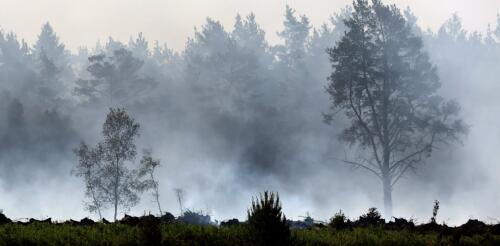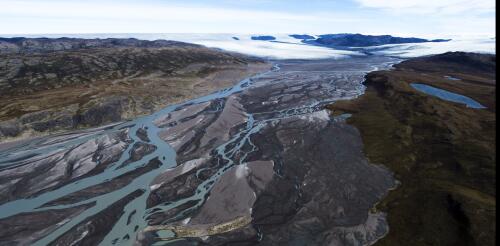Climate change
The blanket of wildfire smoke that spread across large parts of the U.S. and Canada in 2023 was a wake-up call, showing what climate change could feel like in the near future for millions of people. Apocalyptic orange skies and air pollution levels that force people indoors only tell part of the story, though. As global temperatures rise, fires are also spreading farther north and into the Arctic. These fires aren’t just burning in trees and grasses. New research on the exceptional Arctic fire seasons of 2019 and 2020 points to fires moving into the ground as well. These underground fires are known as “zombie fires,” and there are a number of reasons to worry about the trend. A volunteer fights ‘zombie’ peat fires in Siberia in 2020, a year when an estimated 100,000 square miles of forest, grassland and peatland burned, according to an International Association of Wildland Fire analysis. Alexa...
About 400,000 years ago, large parts of Greenland were ice-free. Scrubby tundra basked in the Sun’s rays on the island’s northwest highlands. Evidence suggests that a forest of spruce trees, buzzing with insects, covered the southern part of Greenland. Global sea level was much higher then, between 20 and 40 feet above today’s levels. Around the world, land that today is home to hundreds of millions of people was under water. Scientists have known for awhile that the Greenland ice sheet had mostly disappeared at some point in the past million years, but not precisely when. In a new study in the journal Science, we determined the date, using frozen soil extracted during the Cold War from beneath a nearly mile-thick section of the Greenland ice sheet. A brief look at the evidence beneath Greenland’s ice sheet and the lessons its holds. The timing – about 416,000 years ago, with largely ice-free conditions last...
As scorching heat grips large swaths of the Earth, a lot of people are trying to put the extreme temperatures into context and asking: When was it ever this hot before? Globally, 2023 has seen some of the hottest days in modern measurements, but what about farther back, before weather stations and satellites? Some news outlets have reported that daily temperatures hit a 100,000-year high. As a paleoclimate scientist who studies temperatures of the past, I see where this claim comes from, but I cringe at the inexact headlines. While this claim may well be correct, there are no detailed temperature records extending back 100,000 years, so we don’t know for sure. Here’s what we can confidently say about when Earth was last this hot. This is a new climate state Scientists concluded a few years ago that Earth had entered a new climate state not seen in more than 100,000 years. As fellow climate scientist Nick McKay and I recently discussed in a scientific journal art...
Powerful storm systems that hit the U.S. Northeast starting July 9, 2023, dumped close to 10 inches of rain on New York’s Lower Hudson Valley in less than a day and sent mountain rivers spilling over their banks and into towns across Vermont. Vermont Gov. Phil Scott said he hadn’t seen rainfall like it since Hurricane Irene devastated the region in 2011. Extreme water disasters like this have disrupted lives in countries around the world in the past few years, from the Alps and Western Europe to Pakistan, India and Australia, along with several U.S. states in 2022 and 2023. The role of climate change is becoming increasingly evident in these types of deluges. Cars were stranded in floodwater on the campus of the United States Military Academy at West Point, N.Y., on July 10, 2023. U.S. Military Academy via AP Studies by scientists around the world show that the water cycle has been inte...
The world’s largest shipping companies are starting to update their fleets for a greener future. Maersk received the world’s first dual-fuel methanol container ship in July 2023, and dozens more container ships that can run on alternative fuels are currently on order. The industry – responsible for about 3% of global greenhouse gas emissions, more than Canada and Ireland combined – has reasons to act and to have some confidence in its multimillion-dollar investments. On July 7, the 175 member countries of the International Maritime Organization, a United Nations agency that regulates global shipping, agreed to a new climate strategy that includes reaching net-zero greenhouse gas emissions “by or around, i.e., close to, 2050.” The strategy’s language is vague, obscure and almost noncommittal. But it points the industry toward a cleaner future. New European Union rules will also soon go into effect that will significantly raise costs for...




